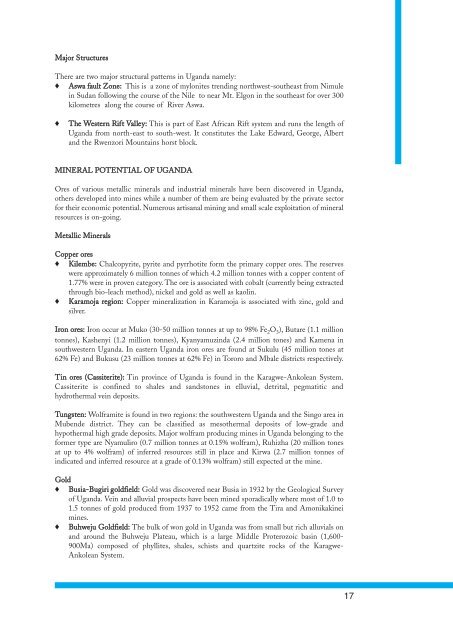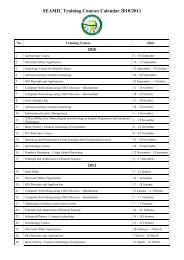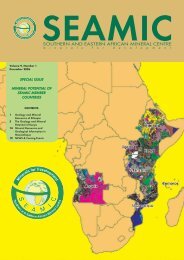SEAMIC Newsletter Vol. 10
SEAMIC Newsletter Vol. 10
SEAMIC Newsletter Vol. 10
Create successful ePaper yourself
Turn your PDF publications into a flip-book with our unique Google optimized e-Paper software.
Major Structures<br />
There are two major structural patterns in Uganda namely:<br />
♦ Aswa fault Zone: This is a zone of mylonites trending northwest-southeast from Nimule<br />
in Sudan following the course of the Nile to near Mt. Elgon in the southeast for over 300<br />
kilometres along the course of River Aswa.<br />
♦<br />
The Western Rift Valley: This is part of East African Rift system and runs the length of<br />
Uganda from north-east to south-west. It constitutes the Lake Edward, George, Albert<br />
and the Rwenzori Mountains horst block.<br />
MINERAL POTENTIAL OF UGANDA<br />
Ores of various metallic minerals and industrial minerals have been discovered in Uganda,<br />
others developed into mines while a number of them are being evaluated by the private sector<br />
for their economic potential. Numerous artisanal mining and small scale exploitation of mineral<br />
resources is on-going.<br />
Metallic Minerals<br />
Copper ores<br />
♦ Kilembe: Chalcopyrite, pyrite and pyrrhotite form the primary copper ores. The reserves<br />
were approximately 6 million tonnes of which 4.2 million tonnes with a copper content of<br />
1.77% were in proven category. The ore is associated with cobalt (currently being extracted<br />
through bio-leach method), nickel and gold as well as kaolin.<br />
♦ Karamoja region: Copper mineralization in Karamoja is associated with zinc, gold and<br />
silver.<br />
Iron ores: Iron occur at Muko (30-50 million tonnes at up to 98% Fe 2 O 3 ), Butare (1.1 million<br />
tonnes), Kashenyi (1.2 million tonnes), Kyanyamuzinda (2.4 million tones) and Kamena in<br />
southwestern Uganda. In eastern Uganda iron ores are found at Sukulu (45 million tones at<br />
62% Fe) and Bukusu (23 million tonnes at 62% Fe) in Tororo and Mbale districts respectively.<br />
Tin ores (Cassiterite): Tin province of Uganda is found in the Karagwe-Ankolean System.<br />
Cassiterite is confined to shales and sandstones in elluvial, detrital, pegmatitic and<br />
hydrothermal vein deposits.<br />
Tungsten: Wolframite is found in two regions: the southwestern Uganda and the Singo area in<br />
Mubende district. They can be classified as mesothermal deposits of low-grade and<br />
hypothermal high grade deposits. Major wolfram producing mines in Uganda belonging to the<br />
former type are Nyamuliro (0.7 million tonnes at 0.15% wolfram), Ruhizha (20 million tones<br />
at up to 4% wolfram) of inferred resources still in place and Kirwa (2.7 million tonnes of<br />
indicated and inferred resource at a grade of 0.13% wolfram) still expected at the mine.<br />
Gold<br />
♦ Busia-Bugiri goldfield: Gold was discovered near Busia in 1932 by the Geological Survey<br />
of Uganda. Vein and alluvial prospects have been mined sporadically where most of 1.0 to<br />
1.5 tonnes of gold produced from 1937 to 1952 came from the Tira and Amonikakinei<br />
mines.<br />
♦ Buhweju Goldfield: The bulk of won gold in Uganda was from small but rich alluvials on<br />
and around the Buhweju Plateau, which is a large Middle Proterozoic basin (1,600-<br />
900Ma) composed of phyllites, shales, schists and quartzite rocks of the Karagwe-<br />
Ankolean System.<br />
17




